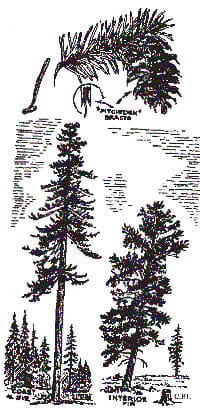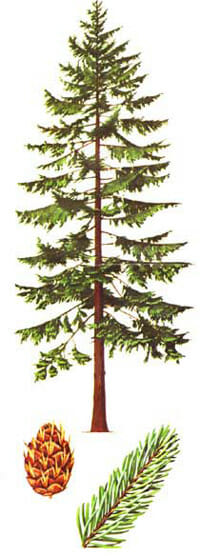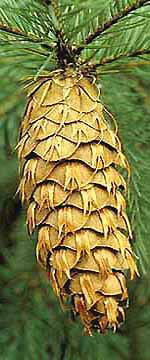Douglas Fir – Coniferales Pinaceae Pseudotsuga menziesii
 |
 |
 |
Identification & Description:
The Douglas fir belongs to the family Pinaceae. It is classified as Pseudotsuga menziesii. It is also known as Coast Douglas-fir, Oregon Pine, Oregon Douglas-fir, Douglas Tree, Interior Douglas-fir
The Douglas fir, common name for a large coniferous tree, is not a true fir but rather a false hemlock. It has been a toxonomic nightmare to fit it into one genus. Consequently, its name has changed several times, with scientists finally settling on its present scientific name. Its common name was designated for the British botanist, David Douglas, who who introduced many of British Columbia’s native conifers into Europe. The Douglas fir occasionally reaches a height of 76 m (250 ft) and commonly grows to 60 m (200 ft) in height and 2 m (6 ft) in diameter. It is the most important timber tree of the western United States and British Columbia and is particularly abundant in Oregon and Washington. Douglas fir lumber, usually known as Oregon pine or yellow fir, amounts annually to about one-fourth of all the lumber produced in the United States. The saplings are popular as Christmas trees
Foliage
Evergreen needles. Foliage is blue-green to dark green. Needles are about one inch long. Pyramidal shape in youth becomes less defined with age.
Location
• Southern mainland coast, Vancouver Island
• An interior variety is found throughout southern and central BC
Size
• Can reach up to 85 metres in height on the coast and 42 metres in the interior
Cones
• 5 to 11 cm long
• Green when young, turning to brown as they age
• Papery scales, with three pronged bracts (resembling mouse hind legs and tail) in between them
• Have winged seeds
• Seeds are eaten by birds and small animals
Needles:
• flat with pointed tips
• bright yellowish-green with single groove on upper surface
• paler colour on lower surface
• spirally arranged so appear to stand out around the twig
Bark
• smooth, grey-brown, blistered when young
• furrowed, thick, dark reddish-brown ridges as the tree ages
• bears scrape off the bark to eat the sap layer beneath
Characteristics
An evergreen tree growing to zone 7 and is frost tender. It is in leaf all year, in flower from March to May, and the seeds ripen from September to November. The scented flowers are monoecious (individual flowers are either male or female, but both sexes can be found on the same plant) and are pollinated by Wind. We rate it 2 out of 5 for usefulness.
The plant prefers light (sandy), medium (loamy) and heavy (clay) soils. The plant prefers acid and neutral soils. It cannot grow in the shade. It requires moist or wet soil. The plant can tolerates strong winds but not maritime exposure.
Uses of Douglass Fir
• modern – heavy duty construction such as wharves, trestles, bridge parts and commercial buildings
• traditional – wood: fuel, fishing hooks, handles, snowshoes, fishtraps; boughs: floor coverings; seeds: eaten; twigs/needles: can exude a sugar like substance which was prized
A light brown dye is obtained from the bark
The bark is a source of tannins
The bark can be used as a cork substitute and is also used to make fertilizer.
The bark contains pitch, it burns with a lot of heat and almost no smoke, so it is prized as a fuel
The small roots have been used to make baskets
The plant has insecticidal properties
A resin is obtained from the trunk, similar to Abies balsamea which is used in the manufacture of glues, candles, as a cement for microscopes and slides and also as a fixative in soaps and perfumery. The resin can also be used as a caulking material on boats.
A fast growing and fairly wind-resistant tree, it is often used in shelterbelt plantings.
Wood – heavy, strong, fine grained, durable, though it can be of variable quality. It dries quickly, does not warp and is easily worked, it is used for heavy construction, telegraph poles, furniture etc. It is also used as a good quality fuel.
The east-west range of Douglas-fir is the greatest of any commercial conifer of western North America. Its native range is from central British Columbia, south along the Pacific Coast Ranges for about 1,367 miles south, representing the range of the typical coastal or green variety, menziesii. The longer arm stretches along the Rocky Mountains into the mountains of central Mexico over a distance of nearly 2,796 miles, comprising the range of the other recognized variety, glauca – Rocky Mountain or blue.
Nearly pure stands of Douglas-fir continue south from their northern limit on Vancouver Island through western Washington, Oregon, and the Klamath and Coast Ranges of northern California as far as the Santa Cruz Mountains. In the Sierra Nevada, Douglas-fir is a common part of the mixed conifer forest as far south as the Yosemite region. The range of Douglas-fir is fairly continuous through northern Idaho, western Montana, and northwestern Wyoming. Several outliers are present in Alberta and the eastern-central parts of Montana and Wyoming, the largest being in the Bighorn Mountains of Wyoming. In northeastern Oregon, and from southern Idaho south through the mountains of Utah, Nevada, Colorado, New Mexico, Arizona, extreme western Texas, and northern Mexico.
Cultivation details
Prefers a moist but not water-logged alluvial soil. Dislikes calcareous soils. Trees are a failure on dry hungry soils.. Whilst they are moderately wind resistant, tall specimens are likely to lose their crowns once they are more than 30 metres tall in all but the most sheltered areas.
A very ornamental tree, it is the most cultivated timber tree in the world and is extensively used for re-afforestation in Britain. There are several named varieties selected for their ornamental value.
Trees can be established in light shade but this must be removed in the first few years or growth will suffer.
Very slow growing for its first few years, growth soon becomes extremely fast with new shoots of up to 1.2 metres a year. This annual increase can be maintained for many years. Trees in sheltered Scottish valleys have reached 55 metres in 100 years. New growth takes place from May to July. The trees require abundant rainfall for good growth.
Trees should be planted into their permanent positions when they are quite small, between 30 and 90cm. Larger trees will check badly and hardly put on any growth for several years. This also badly affects root development and wind resistance.
Trees are very long-lived, specimens over 1,000 years old are known. Seed production commences when trees are about 10 years old, though good production takes another 15 – 20 years. Good crops are produced about every 6 years.
This tree is a pioneer species because it cannot reproduce under its own canopy.
The bark on mature trees can be 30cm thick, and this insulates the trunks from the heat of forest fires.
This species is notably resistant to honey fungus. Young growth can be damaged by late frosts.
The leaves have a strong sweet fruity aroma.